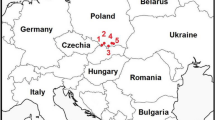Abstract
Forest community dynamics were studied for 4 years in a 6 ha permanent plot of species rich, old-growth, temperate deciduous forest in Ogawa Forest Reserve, central Japan. The gap formation rate, recruitment, mortality, gain and loss rate in basal area during 4 years were 42 m2 ha−1 yr−1, 1.74% yr−1, 1.19% yr−1, 1.12% yr−1 and 0.88% yr−1, respectively. The turnover time calculated from them ranged from 58 to 240 years. Both the mortality and mortality factors were size dependent; trees in middle size class had smallest mortality, and the proportion of the trees killed by disturbances increased with size. Gap creations were concentrated in a particular year, suggesting a large heterogeneity in time. Spatial distribution of recruited trees were biassed to the old gaps (older than 4 years), especially that of the species with Bell-shaped dbh distribution (shade intolerant) strongly associated with the gaps. Recruitment in tree stems and the loss of basal area, thus had the larger variability than mortality of stems and this forest, and the species with L-shaped dbh distribution seemed to going to increase the importance in the future if the present trend continues to be held. The turnover time of population is positively correlated with the maximum dbh size of the species, indicating the slow change of the population of large sized species.
Similar content being viewed by others
References
Brokaw, N. V. L. 1985. Treefalls, regrowth, and community structure in tropical forests. In: Pickett, S. T. A. & White, P. S. (eds), The ecology of natural disturbance and patch dynamics. Academic Press, New York, pp. 53–71.
Harcombe, P. A. 1986. Stand development in a 130-year-old spruce-hemlock forest based on age structure and 50 years of mortality data. For. Ecol. Manage. 14: 41–58.
Harcombe, P. A. 1987. Tree life table. Simple birth, growth, and death data encapsulated life histories and ecological roles. Bio-Science 37: 557–568.
Hubbell, S. P. 1979. Tree dispersion, abundance, and diversity in a tropical dry forest. Science 203: 1299–1309.
Hubbell, S. P. & Foster, R. B. 1986. Biology, chance, and history and the structure of tropical forest communities. In: Diamond, J. & Case, T. J. (eds), Community Ecology. Harper & Row, New York, pp. 314–329.
Hubbell, S. P. & Foster, R. B. 1990. The fate of juvenile trees in a neotropical forest: implications for the natural maintenance of tropical tree diversity. In: Bawa, K. S. & Hadley, M. (eds) Reproductive Ecology of tropical forest plants. Man and Biosphere Series, Vol. 7. UNECSO/International Union of Biological Sciences, Paris, pp. 317–341.
Lieberman, D. & Lieberman, M. 1987. Forest tree growth and dynamics at La Selva, Costa Rica (1969–1982). J. Trop. Ecol. 3: 347–358.
Likens, G. E. (ed) 1987. Long-term studies in ecology. Springer-Verlag, New York.
Manokaran, N. & Kochummen, K. M. 1987. Recruitment, growth and mortality of tree species in a lowland dipterocarp forest in Peninsular Malaysia. J. Trop. Ecol. 3: 315–330.
Masaki, T., Suzuki, W., Niiyama, K., Iida, S., Tanaka, H. & Nakashizuka, T. 1992. Community structure of a species rich temperate forest, Ogawa Forest Reserve, central Japan, Vegetatio 98: 97–111.
Nakashizuka, T. 1987. Regeneration dynamics of beech forests in Japan. Vegetatio 69: 169–175.
Nakashizuka, T. 1991a. The Importance of long-term studies of forest dynamics in large plots. Jap. J. Ecol. 41: 45–53.
Nakashizuka, T. 1991b. Population dynamics of coniferous and broad-leaved trees in a Japanese temperate mixed forest. J. Veg. Sci. 2: 413–418.
Ohwi, J. & Kitagawa, M. 1983. New flora of Japan, Shibundo, Tokyo.
Platt, W. J., Evans, G. W. & Rathbun, S.L. 1988. The population dynamics of a long-lived conifer (Pinus palustris). Am. Nat. 131: 491–525.
Risser, P. G. (ed) 1991. Long-term ecological research. An international perspective. John Wiley & Sons, Chichester.
Runkle, J. R. 1985. Disturbance regimes in temperate forests. In: Pickett, S. T. A. & White, P. S. (eds), The ecology of natural disturbance and patch dynamics. Academic Press, New York, pp. 17–33.
StrongJr., D. R. 1983. Natural variability and the manifold mechanisms of ecological communities. Am. Nat. 122: 636–660.
Swaine, M. D., Hall, J. B. & Alexander, I. J. 1987. Tree population dynamics at Kade, Ghana (1968–1982). J. Trop. Ecol. 3: 331–346.
Swaine, M. D., Lieberman, D. & Putz, F. E. 1987. The dynamics of tree populations in tropical forest: a review. J. Trop. Ecol. 3: 359–366.
Welden, C. W., Hewett, S. W., Hubbell, S. P. & Foster, R. B. 1991. Sapling survival, growth, and recruitment: relationship to canopy height in a neotropical forest. Ecology 72: 35–50.
Whitmore, T. C. 1989. Canopy gaps and the two major groups of forest trees. Ecology 70: 536–537.
Yamamoto, S. 1989. Gap dynamics in climax Fagus crenata forests. Bot. Mag. Tokyo 102: 93–114.
Author information
Authors and Affiliations
Rights and permissions
About this article
Cite this article
Nakashizuka, T., Iida, S., Tanaka, H. et al. Community dynamics of Ogawa Forest Reserve, a species rich deciduous forest, central Japan. Vegetatio 103, 105–112 (1992). https://doi.org/10.1007/BF00047696
Accepted:
Issue Date:
DOI: https://doi.org/10.1007/BF00047696




